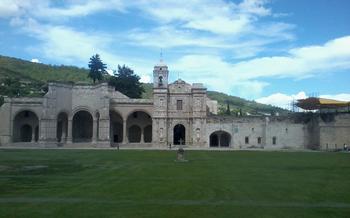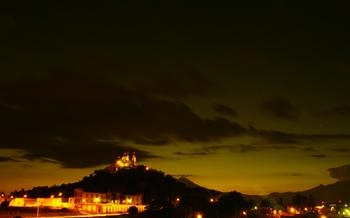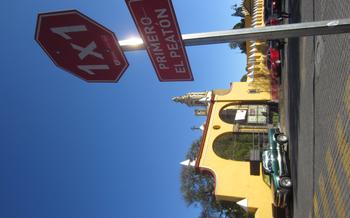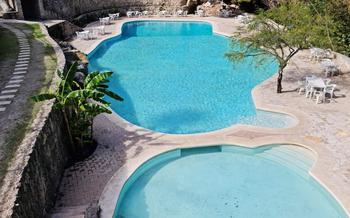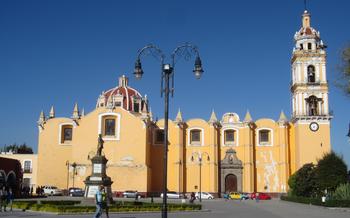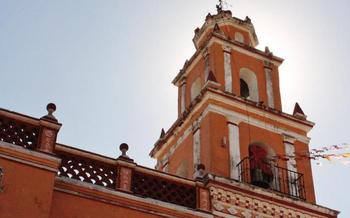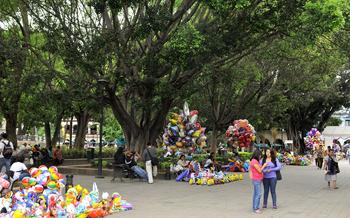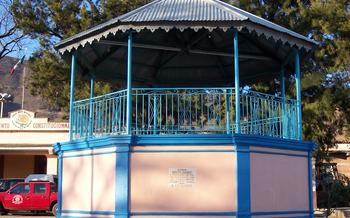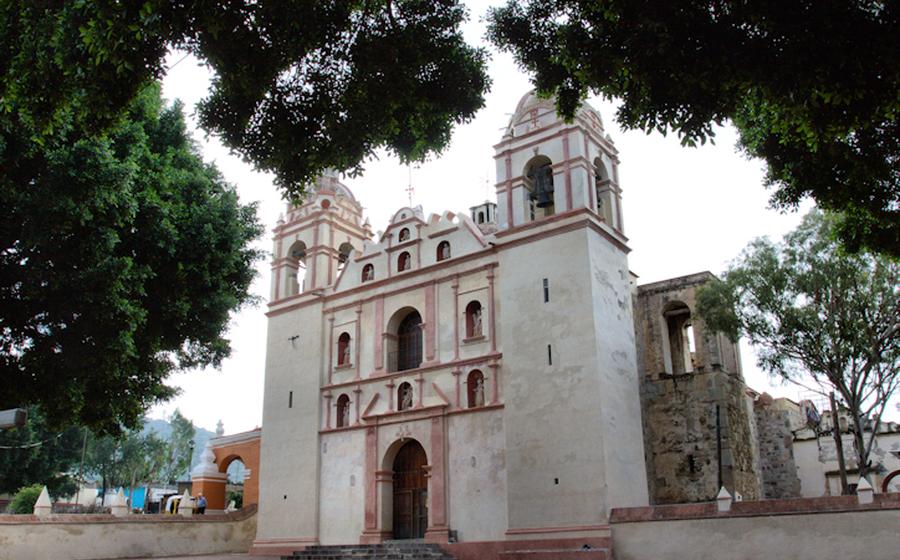
San Jerónimo Tlacochahuaya
- Architecture and Design of the Church
- The Murals of San Jerónimo Tlacochahuaya
- The Dominican Order and Their Role
- The Town of San Jerónimo Tlacochahuaya
- Visiting the Church of San Jerónimo Tlacochahuaya
- The Façade of the Church and Its Carvings
- The Interior Features of the Church
- The Murals of the Life of Saint Jerome
- The Murals of the Last Judgment
- The Role of the Dominicans in the Community
- The Town's Cultural and Ethnic Makeup
- The Town's Main Industries and Economic Activities
- Insider Tip: Exploring the Surrounding Area
Architecture and Design of the Church
The Church of San Jerónimo Tlacochahuaya stands out for its unique blend of architectural styles, reflecting the convergence of indigenous and European influences. Its most striking feature is the open chapel, a rare and awe-inspiring design element. The façade, with its intricate carvings and sculptures, showcases the artistic mastery of the Dominican builders. The interior of the church is equally impressive, adorned with beautiful altarpieces, paintings, and sculptures, each narrating stories and conveying religious symbolism. This harmonious fusion of architectural styles and artistic elements creates a profound and immersive experience for visitors, transporting them back to a time when faith and artistry intertwined.
The Murals of San Jerónimo Tlacochahuaya
The Church of San Jerónimo Tlacochahuaya is renowned for its stunning murals, which hold immense historical, artistic, and religious significance. Created by indigenous Zapotec artists under the guidance of Dominican friars, these murals tell the stories of the life of Saint Jerome, the patron saint of the church, as well as depict scenes from the Bible, including the Last Judgment.
The murals were painted using a variety of techniques, including fresco, tempera, and oil, and feature a vibrant color palette and intricate iconography. Zapotec artistic traditions and influences are evident in the murals, blending seamlessly with European artistic styles.
The murals have undergone extensive restoration efforts in recent years, revealing their original beauty and preserving them for future generations. They serve as a testament to the artistic prowess and cultural heritage of the Zapotec people, and remain a source of inspiration and awe for visitors from around the world.
The Dominican Order and Their Role
The arrival of the Dominican order in Mexico marked a significant chapter in the history of San Jerónimo Tlacochahuaya. The Dominicans, known for their missionary work and their commitment to education, played a pivotal role in shaping the town's religious, cultural, and social landscape.
In the early 16th century, Dominican friars arrived in the region, eager to spread Christianity among the indigenous population. They established a mission in Tlacochahuaya, building a church and a monastery. The Dominicans worked tirelessly to convert the local Zapotec people, teaching them about the Catholic faith and introducing new customs and traditions.
Beyond their religious work, the Dominicans also made significant contributions to the community's development. They established schools and hospitals, providing education and healthcare to the local population. They also introduced new agricultural techniques and promoted economic development, helping to improve the living standards of the people.
The Dominicans' presence in Tlacochahuaya left a lasting legacy. Their work laid the foundation for the town's strong Catholic identity and contributed to its rich cultural heritage. The Dominican order's commitment to education and social welfare continues to inspire and guide the community to this day.
The Town of San Jerónimo Tlacochahuaya
The town of San Jerónimo Tlacochahuaya, nestled in the valley of Oaxaca, has a rich history and a vibrant cultural heritage. Its origins can be traced back to the pre-Hispanic era, when it was inhabited by the Zapotec people. The name Tlacochahuaya is derived from the Nahuatl language, meaning "place of the owls."
During the colonial period, the town came under Spanish rule, and the Dominicans established a monastery and church in the 16th century. This led to the introduction of Catholicism and the blending of indigenous and Spanish cultures.
The town's population is predominantly Zapotec, with a significant Mestizo population. The Zapotec language is still widely spoken, and many traditional customs and practices are preserved. The town's economy is based on agriculture, with corn, beans, and squash being the main crops. Tourism is also a growing industry, as visitors are drawn to the town's colonial architecture, vibrant culture, and natural beauty.
San Jerónimo Tlacochahuaya is a town that has managed to preserve its unique identity while embracing progress and development. It is a place where the past and present coexist harmoniously, offering visitors a glimpse into the rich history and vibrant culture of Oaxaca.
Visiting the Church of San Jerónimo Tlacochahuaya
The church of San Jerónimo Tlacochahuaya is open to visitors from Tuesday to Sunday, from 9 am to 5 pm. The entrance fee is 50 pesos (approximately 50 USD), and guided tours are available for an additional fee. Visitors are expected to dress respectfully and refrain from taking photos inside the church.
There are several attractions and points of interest within walking distance of the church. The Zapotec Museum showcases the rich history and culture of the indigenous Zapotec people. The Mercado de Artesanías (Artisan Market) offers a vibrant display of locally made crafts and souvenirs. The Jardín Central (Central Park) is a pleasant place to relax and soak in the atmosphere of the town.
A trip to San Jerónimo Tlacochahuaya is a rewarding experience for anyone interested in history, art, and culture. The church of San Jerónimo Tlacochahuaya stands as a testament to the enduring legacy of the Dominican order and the vibrant cultural heritage of Oaxaca.
The Façade of the Church and Its Carvings
The façade of the church is a masterpiece of intricate carvings that showcase the skill and artistry of the indigenous craftsmen who worked on its construction. The carvings depict biblical and historical scenes, as well as symbolic motifs and hidden meanings. The main portal features a relief of the Last Judgment, with Christ surrounded by angels and saints. Other carvings depict scenes from the life of Christ, the Virgin Mary, and various saints. The intricate details and symbolism of the carvings make the façade a captivating sight that invites visitors to explore its hidden stories and meanings. The Zapotec craftsmen who created these carvings combined their traditional artistic techniques with European influences, resulting in a unique blend of styles that is both awe-inspiring and deeply meaningful.
The Interior Features of the Church
Stepping inside the Church of San Jerónimo Tlacochahuaya is a feast for the eyes, as its intricate interior features captivate visitors. The altarpieces, crafted with meticulous precision, showcase the artistic prowess of the Dominican friars and local artisans. Each altarpiece narrates a biblical story through intricate carvings, vibrant colors, and gilded accents.
The paintings that adorn the walls and ceilings depict biblical scenes, saints, and angels. These masterpieces, executed with vibrant hues and skillful brushstrokes, convey a sense of divine presence and evoke a profound sense of spirituality.
The stained glass windows, masterpieces of artistry and craftsmanship, bathe the interior in a kaleidoscope of colors. The windows depict scenes from the Bible and the life of Saint Jerome, casting a mystical glow upon the sacred space.
Unique architectural elements, such as vaulted ceilings, arches, and columns, contribute to the awe-inspiring grandeur of the church. These elements create a sense of harmony and balance, drawing the eye upward towards the heavens.
The Murals of the Life of Saint Jerome
The murals of the life of Saint Jerome hold a significant place within the church, narrating the saint's journey through a series of vibrant and captivating scenes. Saint Jerome, a renowned figure in the history of the church, is depicted in these murals as a scholar, translator, and ascetic. The artists have skillfully portrayed key events from his life, including his time in the desert, his work on the translation of the Bible, and his interactions with other saints and figures.
Executed with precision and artistry, these murals showcase a unique blend of indigenous and European influences. The use of bright colors, intricate patterns, and symbolic motifs adds to their visual appeal, making them a true masterpiece of religious art. The murals serve as a testament to the enduring legacy of Saint Jerome and his profound impact on the Christian faith. They offer visitors a glimpse into his life and teachings, inspiring reflection and devotion.
The Murals of the Last Judgment
The church of San Jerónimo Tlacochahuaya is also home to a series of murals depicting the Last Judgment. These murals are located on the walls of the nave and are considered to be some of the most impressive examples of colonial art in Mexico. The murals were created by indigenous artists under the direction of Dominican friars and depict a vivid and dramatic portrayal of the Last Judgment. The murals show the separation of the saved and the damned, with the saved being led to heaven by angels and the damned being dragged to hell by demons. The murals are a powerful reminder of the consequences of sin and the importance of leading a virtuous life. The artistic style of the murals is a blend of indigenous and European influences, and the murals are notable for their use of bright colors and intricate details. The Last Judgment murals are a must-see for anyone interested in colonial art and Mexican history.
The Role of the Dominicans in the Community
The arrival of the Dominican order in Tlacochahuaya marked a significant turning point in the town's history. The Dominicans, known for their dedication to education and religious work, played a pivotal role in shaping the community's social, cultural, and economic landscape.
One of the most notable contributions of the Dominicans was the establishment of schools and hospitals. They recognized the importance of education in empowering the local population and worked tirelessly to provide access to quality education for both boys and girls. The Dominicans also established hospitals and clinics, providing much-needed healthcare services to the community.
In addition to their educational and healthcare initiatives, the Dominicans actively promoted agriculture and economic development. They introduced new farming techniques, encouraged the cultivation of cash crops, and helped establish cooperatives to support local farmers. Their efforts contributed to the town's economic growth and improved the livelihoods of many families.
The Dominicans' presence in Tlacochahuaya extended beyond their religious and educational work. They actively engaged with the community, promoting social justice and cultural exchange. Their efforts to blend indigenous traditions with Catholic beliefs and practices resulted in a unique syncretic culture that continues to define the town's identity.
The legacy of the Dominican order in Tlacochahuaya is still evident today. The educational institutions they established continue to provide quality education to the community, and the hospitals they founded continue to provide essential healthcare services. The town's cultural identity, shaped by the Dominicans' influence, remains a source of pride and inspiration for its people.
The Town's Cultural and Ethnic Makeup
The town of San Jerónimo Tlacochahuaya is a vibrant tapestry of cultures, reflecting the rich heritage of its indigenous Zapotec population and the enduring influence of Spanish culture and Catholicism. The Zapotecs, with their ancient traditions and languages, have inhabited this region for centuries, leaving an indelible mark on the town's identity. Their customs, beliefs, and way of life are deeply intertwined with the fabric of the community.
Over time, Spanish culture and Catholicism arrived in the region, brought by Spanish conquistadors and missionaries. The blending of these two distinct cultures resulted in a unique syncretism, where indigenous traditions and beliefs were fused with Catholic practices and rituals. This cultural fusion is evident in the town's architecture, art, music, and festivals, creating a harmonious blend that distinguishes San Jerónimo Tlacochahuaya from other towns in the region.
The Zapotec language, with its unique sounds and grammar, is still spoken by many residents of San Jerónimo Tlacochahuaya, preserving the town's linguistic heritage. Traditional Zapotec clothing, often adorned with intricate embroidery and vibrant colors, can be seen during special occasions and festivals, showcasing the pride and identity of the indigenous community.
Despite the influences of Spanish culture, the Zapotec people have managed to maintain their distinct identity and traditions, creating a harmonious coexistence between the two cultures. This cultural diversity is one of the town's greatest assets, enriching its heritage and contributing to its unique character and charm.
The Town's Main Industries and Economic Activities
The town of San Jerónimo Tlacochahuaya has traditionally relied on agriculture as its primary economic activity. The fertile lands surrounding the town have been cultivated for centuries, with farmers growing a variety of crops such as corn, beans, and squash. Traditional farming practices, passed down from generation to generation, are still widely used, showcasing the town's deep connection to its agricultural heritage.
In recent years, tourism has emerged as a significant economic driver for San Jerónimo Tlacochahuaya. The town's rich cultural heritage, stunning architecture, and proximity to other popular tourist destinations have attracted a growing number of visitors. This has led to the development of small businesses, guesthouses, and restaurants, providing new opportunities for locals to earn a livelihood.
Additionally, the town has fostered the growth of cooperatives and small businesses, which play a vital role in supporting the local economy. These enterprises often focus on traditional crafts, such as weaving and pottery, as well as the production of local delicacies like mezcal and chocolate. By supporting these initiatives, the community aims to preserve its cultural traditions while creating sustainable economic opportunities.
Despite these positive developments, San Jerónimo Tlacochahuaya continues to face challenges related to economic development. Limited access to financing and resources, as well as competition from larger markets, can hinder the growth of local businesses. The community is working to address these challenges through collaboration and the promotion of fair trade practices, ensuring that the benefits of economic growth are shared equitably among its members.
Insider Tip: Exploring the Surrounding Area
Venturing beyond the Church of San Jerónimo Tlacochahuaya, you'll discover a wealth of hidden gems waiting to be explored. Take a leisurely stroll through the neighboring villages and towns, where you'll encounter a vibrant tapestry of local life. Immerse yourself in the bustling atmosphere of the markets, where you can haggle for unique handcrafted souvenirs and sample delectable local delicacies. Don't miss the opportunity to engage with the friendly locals, who are always eager to share stories and insights into their rich cultural heritage.
For nature enthusiasts, the surrounding area offers a breathtaking canvas of natural wonders. Embark on a scenic hike through the verdant hills, where you'll be rewarded with panoramic vistas that will leave you breathless. Explore the lush forests, home to a diverse array of flora and fauna, and uncover hidden waterfalls and sparkling rivers. Whether you prefer adrenaline-pumping activities or tranquil moments of contemplation, the natural beauty of the region beckons you to create lasting memories.
